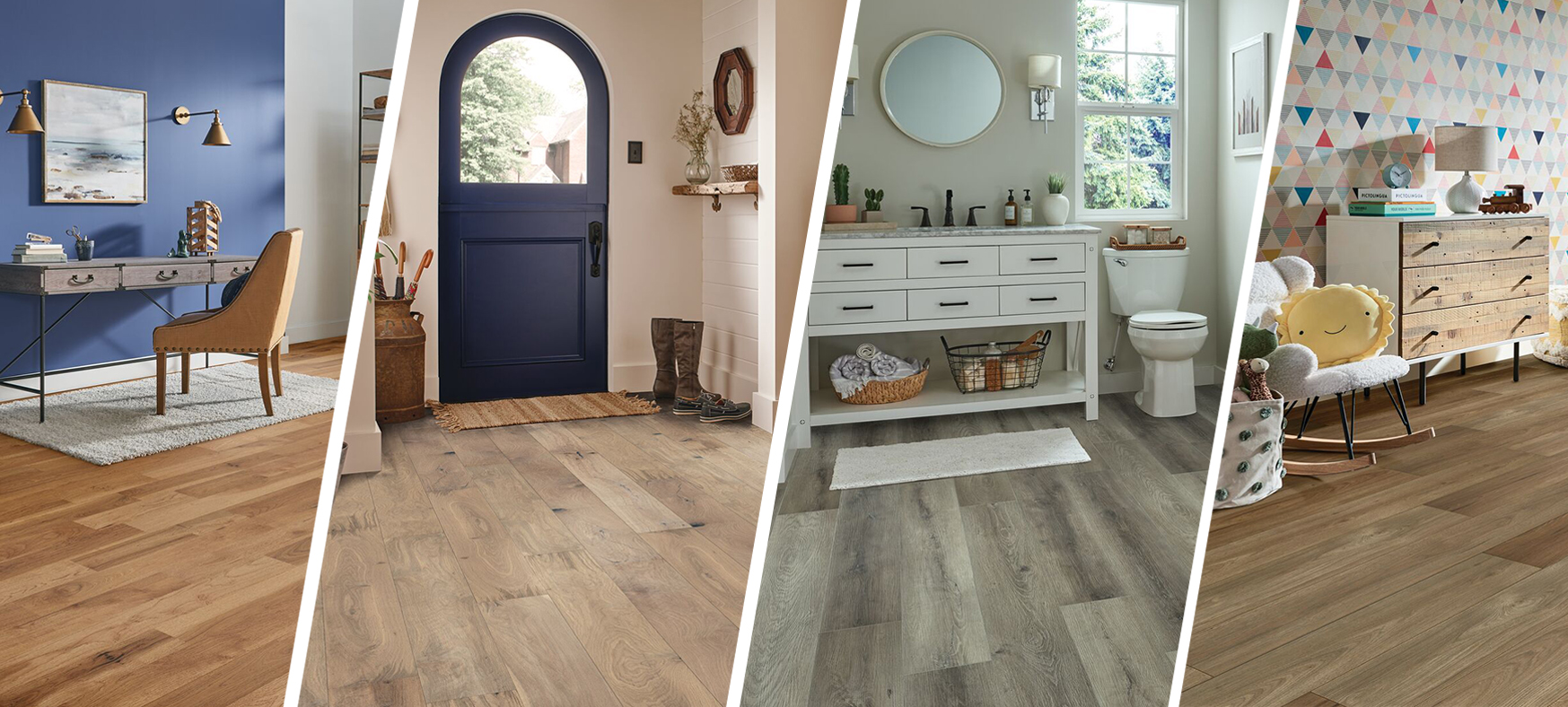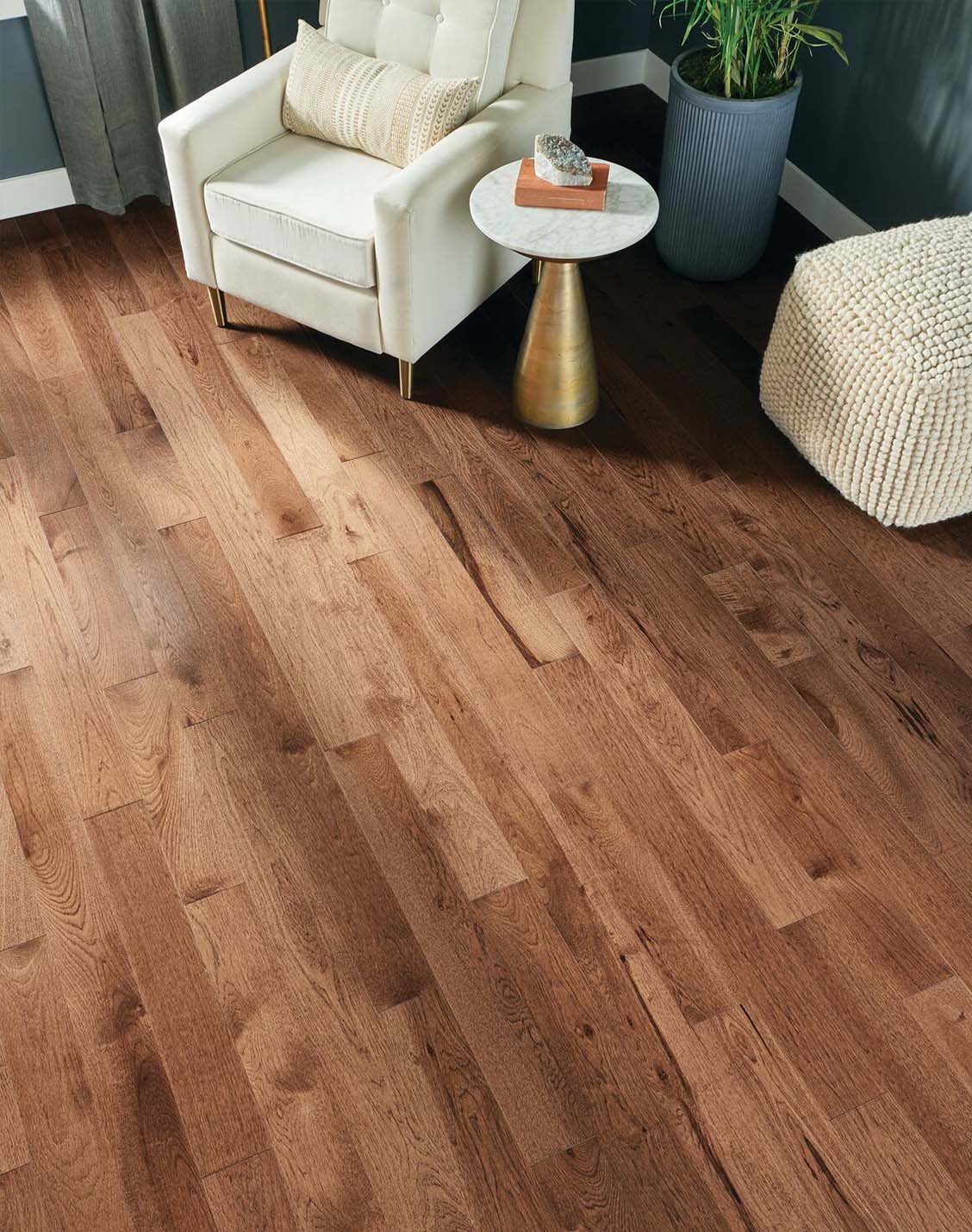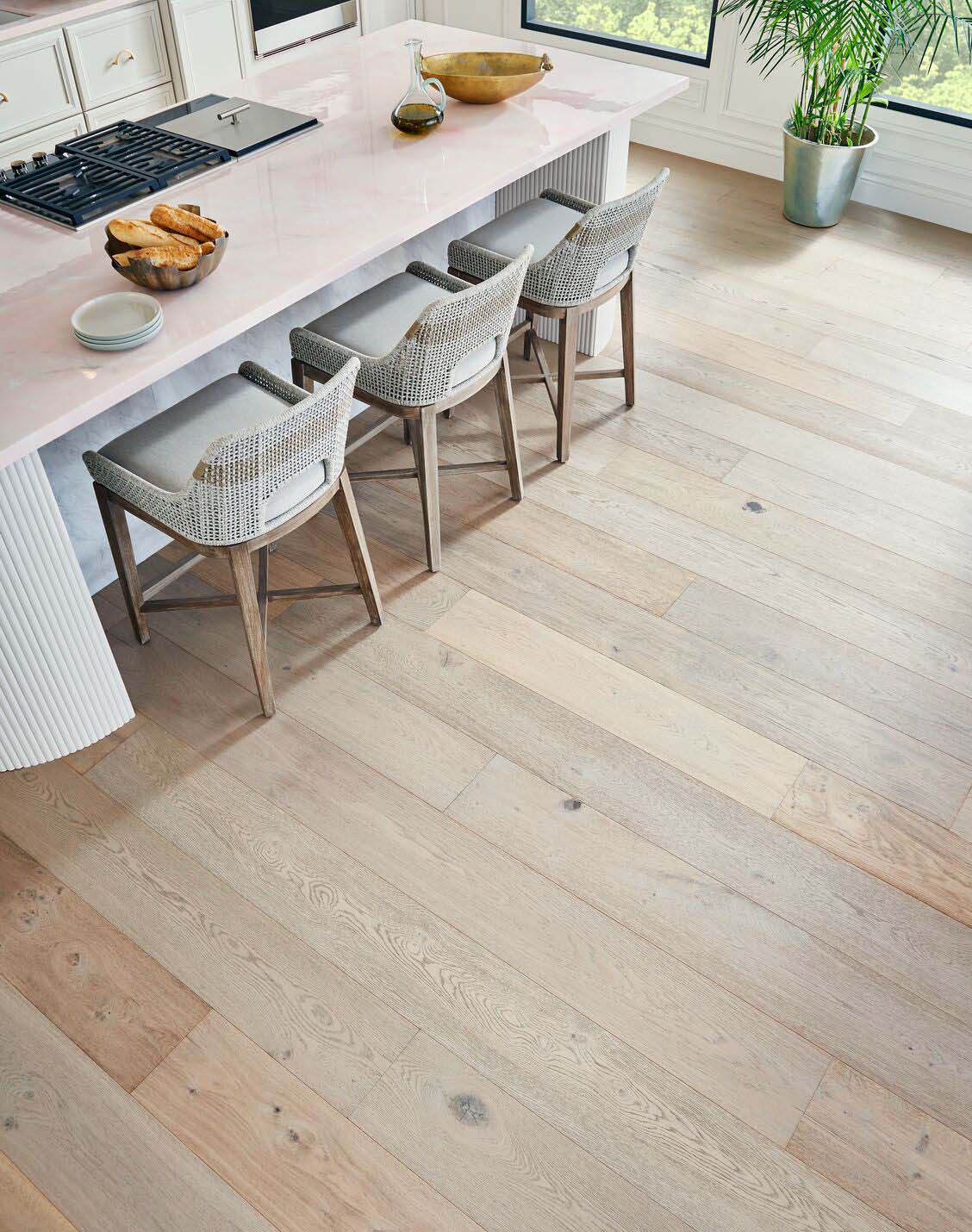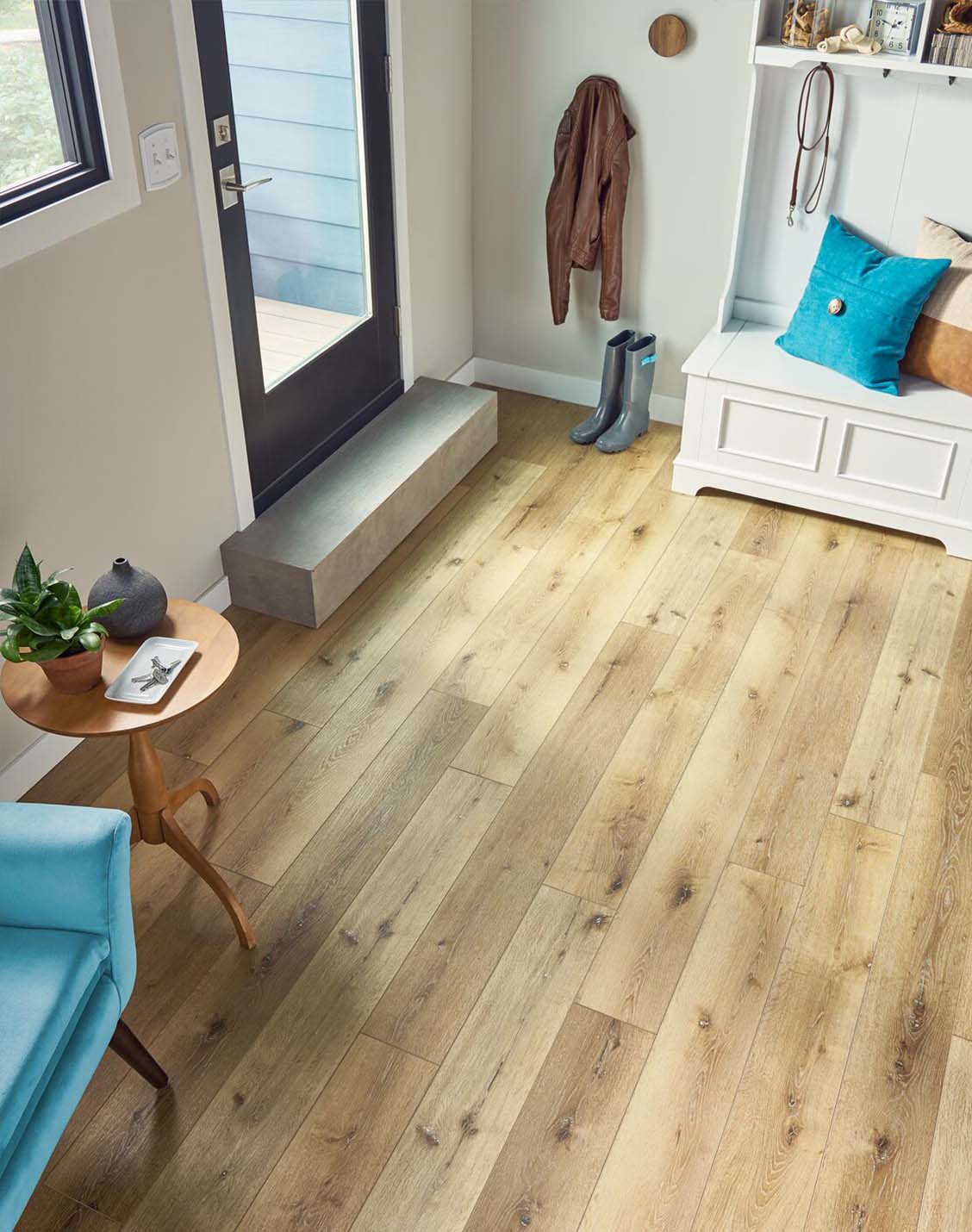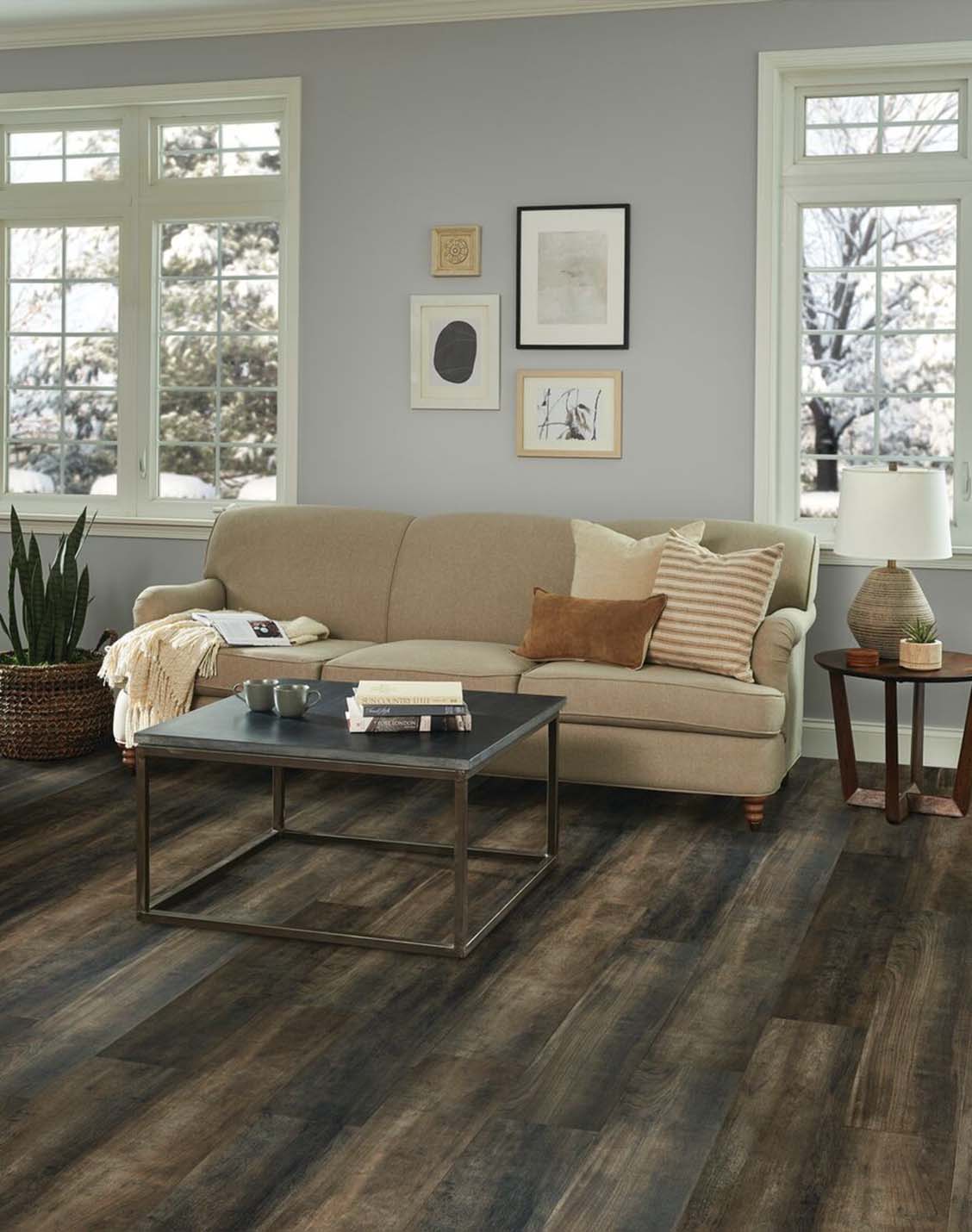-
Let’s start with the real deal, solid hardwood flooring. As the name suggests, solid hardwood floors come from solid wood. So each plank comes from a single piece of hardwood, typically ¾ of an inch thick.
Solid oak flooring remains the most popular type of hardwood flooring. But you can select from any number of species. Some of the more common hardwoods include some common maple, hickory, walnut, and ash. However, you can choose from more exotic hardwood flooring species like Brazilian Cherry, Brazilian Walnut, Tigerwood, and Lacewood.
Generally, hardwood planks use tongue-and-groove for installation with staples or nails.
Check out Robbins solid hardwood flooring options here!
Not surprisingly, solid hardwood flooring has its pros and cons. Here’s a look at each:
Solid Hardwood Pros
• For most people, no other flooring matches the beauty of solid hardwood.
• Hardwood floors last a lifetime and more. You can refinish them every 8-10 years to remove scratches and other blemishes and restore their original beauty.
• Solid hardwood offers simple maintenance.
• Hardwoods add value to your property. For instance, the average ROI for installing hardwood flooring is 70-80 percent, according to Realtor.com.
Solid Hardwood Cons
• Solid hardwood costs more to install, averaging $6 to $12 per square foot.
• Hardwood floors will show scratches and gouges over time if you have high traffic. For example, pets can be particularly problematic.
• Moisture impacts hardwoods, and not in a good way. So if you install hardwood flooring in areas of your home prone to moisture like your basement, it can swell, warp and discolor your floors.
-
Engineered Hardwood Flooring
In the 1960s, the hardwood flooring industry introduced engineered hardwood, primarily for basements and first floors of properties built on concrete slabs. Solid hardwood flooring presented installation issues, so engineered flooring offered an alternative to achieve a similar look with greater ease of installation.
As it turns out, engineered hardwood floors have become so popular today that sales exceed those of solid hardwood.
Engineered hardwood uses a thin veneer of hardwood. But it binds that veneer to different layers of a composite material like plywood. The end product looks like a hardwood floor but affords greater stability than solid hardwood.
More stability lets you install engineered hardwood flooring in locations where its solid hardwood counterpart might have water or humidity concerns. For example, engineered hardwood works well in basements or bathrooms, really level in your house.
Moreover, as mentioned, engineered hardwood installs easily. For starters, you have more options than hardwood. You can nail, staple, glue, or even float an engineered floor. The flooring also locks together to create a tight seam. As a result, engineered hardwood floors have become a favorite for DIY flooring.
Check out Robbins engineered hardwood flooring options here!
Engineered Hardwood Pros
• Engineered hardwoods provide more resistance to moisture and humidity than solid hardwoods.
• You can install engineered hardwood flooring at any level of your house, even below ground. Plus, installation is faster, easier, and less expensive.
• Engineered hardwood is durable and long-lasting.
• You’ll pay slightly less for engineered hardwood flooring than solid hardwood flooring. So, that makes it easier to afford more exotic wood species.
Engineered Hardwood Cons
• Engineered flooring doesn’t offer the longevity of a solid hardwood floor.
• Engineered hardwoods cost more than laminate or SPC flooring.
• The wood surface can still be scratched or dented to show wear in high-traffic areas.
• Despite having greater moisture resistance, don’t mistake engineered hardwood for being waterproof. The floors can’t withstand standing water.
Because engineered flooring is a manufactured product, you need to be wary of low-quality manufacturers that cut corners. Purchase your floors from a reputable manufacturer like Robbins, producing wood flooring since 1894.
-
Rigid Core Vinyl Flooring
Rigid core vinyl flooring is the new kid on the block for wood floor options. Made from a stone plastic composite (SPC), it features a solid polymer core. That core, comprised of polyvinyl, limestone, and stabilizers, is quite dense so rigid core vinyl floors, or SPC floors, are durable, much more so than traditional vinyl floors.
The other key feature of rigid core flooring is that it’s waterproof. Moreover, it’s virtually impossible to distinguish it from a solid wood floor, or stone floor for that matter. The printed vinyl layers deliver real wood looks and textures.
Equally important, rigid core vinyl flooring holds up to traffic. Unlike engineered or solid wood, it resists scratches and dents. So, if you’re looking for pet-friendly flooring, SPC vinyl does the trick.
Although not every rigid core vinyl floor installation includes an underlayment, it’s worth considering. Because of the floor’s rigidity, it can be hard underfoot. As a result, underlayment cushions the floor while also providing better sound absorption.
Check out Robbins rigid core flooring options here!
Rigid Core Vinyl Flooring Pros
• SPC vinyl flooring protects against ultraviolet rays that discolor solid and engineered wood flooring.
• The floorings composite materials significantly reduce scratches, stains, and general wear and tear in high-traffic areas.
• Installation is a breeze. Rigid core vinyl planks click and interlock seamlessly. In addition, you can even install them over your existing flooring.
• If you have moisture concerns, rigid core is 100% waterproof flooring.
• You’ll pay less than solid hardwood to get a wood-look floor. Plus, it will be easier to install.
• The vinyl wood planks resist expansion and contraction caused by humidity. So, your floors won’t gap, buckle, or shrink like a hardwood floor.
• SPC vinyl flooring is easy to clean and maintain.
Rigid Core Vinyl Flooring Cons
• Although realistic, stone plastic composite flooring is still not hardwood flooring.
• Rigid core vinyl flooring costs more than laminate or other vinyl flooring products.
• Although the rigid core delivers exceptional durability, its rigidity makes it less comfortable.
• Don’t expect SPC vinyl to improve your home’s resale value.
• Unlike its hardwood counterparts, rigid core vinyl flooring can’t be refinished or repaired.
If you want the look of solid hardwood without some of the concerns, SPC flooring presents a good option. So check out our lineup of Pro-Tekt rigid core vinyl flooring products. We offer maple, oak, and white oak flooring options. In addition, you can choose from three stone looks.
-
Wood Look Laminate Flooring
That brings us to the last wood floor option on our list – wood look laminate flooring. Laminate flooring starts with a core layer of fiberboard from wood byproducts. Then, it incorporates a printed design layer that resembles wood. Finally, a transparent, hard-wearing layer protects the floor from scratches and stains.
When you shop for laminate flooring, pay attention to abrasion class ratings. The ratings range from one to five, with five being the most durable. Look for a floor with at least a four rating for superior scratch resistance.
Generally, laminate floors lack the thickness of the other wood flooring options mentioned. They’re typically ¼- to 1/2-inch thick. You secure planks with click and lock edges. In addition, laminate usually floats without nailing or gluing.
Although a quality laminate floor looks like wood, it’s easy to spot the difference when you get up close. That’s less true today than in years past, but don’t expect to fool anyone with a wood-look laminate floor.
But laminate floors do excel. First, the floor’s surface resists water and stains. You can even install them over radiant heating systems. Second, they’re easy to clean and maintain. Third, they’re the quintessential DIY floor. And finally, you’ll pay a fraction of the cost for solid or even engineered hardwood.
Check out Robbins laminate flooring options here!
Wood Look Laminate Flooring Pros
• Laminate floors handle high traffic with minor damage. Plus, they don’t scratch or discolor like natural hardwood, so that you can use them in rooms with large windows. And, they’re stain-resistant.
• Wood-look laminate flooring costs substantially less than solid hardwood.
• Floor purchase costs aside, laminate is easier to install when compared to other wood floor options.
• Not surprisingly, wood-look laminate floors offer considerable savings versus engineered and solid wood floors. They cost less to purchase and less to install. Indeed, laminate floor installation often costs 50 percent less than hardwood.
• You have a myriad of styles and designs from which to select.
• Laminate flooring requires less maintenance for upkeep.
• Some wood-look vinyl floorings offer 100% waterproof performance. So pay attention. Laminate floors won’t hold up to wet conditions.
Wood Look Laminate Flooring Cons
• Laminate floors won’t last nearly as long despite the wood look, mainly because you can’t refinish them. So you should expect a lifespan of 15 to 25 years.
• Depending on the flooring you purchase, you could wind up with a fake appearance. Remember, laminate uses a design layer so the wood grain can look artificial from some manufacturers. It’s not real wood, even if it seems like it.
• As with rigid core vinyl flooring, you’ll want to include an underlayment to cushion the floor and improve its feel underfoot.
• Laminate flooring repairs less readily than hardwood.
• Sustainable wood floors offer a better solution if you’re a steward of the environment.

